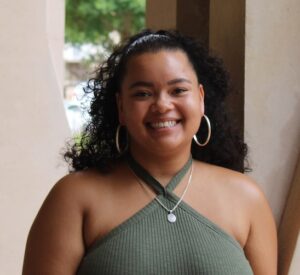
Skylar Grimsley is a PhD student in the lab of Chrystal Starbird, PhD, assistant professor in the Department of Biochemistry and Biophysics and member of the Pathobiology and Translational Science Program. In the lab, Grimsley is studying the pathophysiology of Alzheimer's disease and how those processes might be influenced by genetic variations of a protein called ATP binding cassette protein A7, or ABCA7. The particular genetic variants that Grimsley is examining are more common in Latino/a and African American populations.
Q: What were your interests when young, and how did you get into biomedical science?
A: When I was younger, I had a wide array of interests. I played clarinet in my high school's symphonic band, was editor-in-chief of the school's literary magazine, played volleyball, and was an active member of the science club. Joining the science club kickstarted my interest in medical research. The more I learned about science, the more curious I became.
Participating in this club resulted in me pursuing a medical shadow-ship program at Genesis Hospital, and eventually attending Norfolk State University as a biology major, chemistry minor. From there, I was introduced to various scientific careers and paths and I subsequently decided that biomedical research was the path for me.
Q: Why did you choose UNC and the lab you are in?
A: I chose to come to the University of North Carolina at Chapel Hill for graduate school because of the extensive research personnel and facilities network. I knew that earning my PhD at UNC would mean access to not only cutting-edge technology, but a vast alumni network and various opportunities for career development. Additionally, during the interview process, the graduate students I was introduced to seemed excited and passionate about their work. I believed that UNC was an institution in which I could blossom as a scientist.
When choosing my dissertation lab, it was most important to me to be in an environment where I felt like I could be myself. I wanted to be able to do exceptional science in a way that reflects my values and passions. It was also important to me to work on a project that addresses health disparities. The culture in Dr. Starbird's laboratory, and the collaborative project I am pursuing, make this lab a perfect fit for me.
Q: What are you working on right now?
A: Currently, I am studying ABCA7. Certain genetic variants of this protein were recently identified and shown to increase the conferred risk of developing Alzheimer's disease. Though present in all groups, these genetic variants are most prevalent in African American and Latino/a populations. I aim to understand how these genetic variations influence the genes' protein product, contributing to the pathogenesis of Alzheimer's disease. To be more precise, I use cryogenic electron microscopy, western blot, and fluorescent confocal microscopy to investigate how the ABCA7 gene affects lipid trafficking and regulation in the context of Alzheimer's disease.
Q: What inspires you the most about working in your field?
A: What inspires me most about my field is being able to identify fundamental changes to proteins and using those changes as an opportunity to inform disease states. It is exciting to make scientific advancements that will be built upon and applied to clinical settings.
Q: What are your goals after earning your PhD?
A: I hope to work in science policy after earning my PhD. I aim to contribute to a more ethical, equitable, and progressive approach to healthcare and health education. I also have a passion for mentoring and teaching, so I hope to lead community-based science exposure programs and events, as well as teach classes at the university level.






